Located in the heart of the Aegean Region of Turkey, Hierapolis is a must-see destination for those interested in history and culture. We loved our trip there this year—my kids raved about it for a week afterward.
This is a guide to an ancient city, a holy site of a long-gone civilization, and is truly a hidden gem with many popular tourist attractions surrounding it.
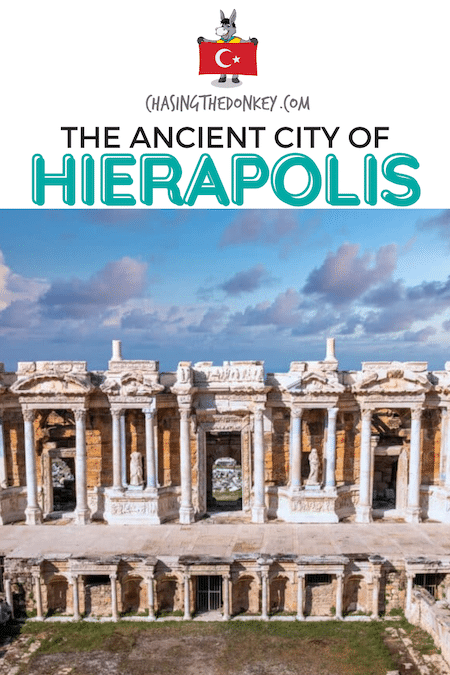
If you’re planning a trip to Türkiye, you should definitely visit Hierapolis and inhale its exciting atmosphere, filled with the majesty of ancient times. And every good trip needs a good guide; that’s why we put up all the information we learned from our recent trip to this ancient city to help you travel with ease.
Keep reading to make the best of your trip to Hierapolis.
Skip Ahead To My Advice Here!
A Brief History Of Hierapolis & Pamukkale
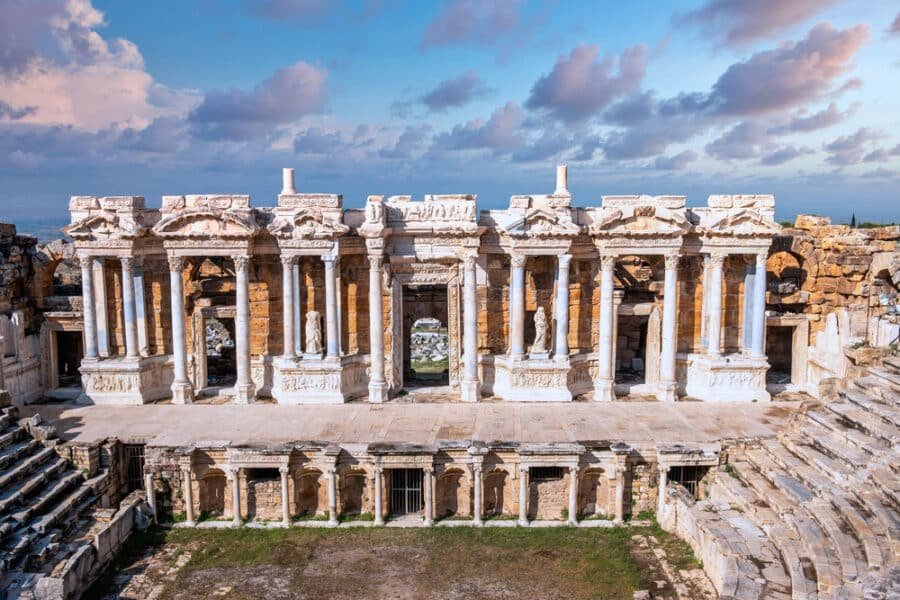
Hierapolis was an important religious and cultural site for the ancient civilizations in southwestern Turkey. Experts believe the area was a cult center dedicated to Cybele before the first Greek colony was founded in the area—the first known settlements in Hierapolis date back to the Iron Age.
Underworld
A Phrygian temple of the mother Goddess Cybele was built in the 7th century BCE. Although the local communities used the temple to worship their gods, once the Greeks arrived, the local culture and religious cults were assimilated into the Greek ones. Under the Phrygian rule, the area was associated with the underworld; this association continued during the subsequent Greek and Roman periods. Greeks associated the temple of Hierapolis with Hades, or Pluton, in Roman mythology.
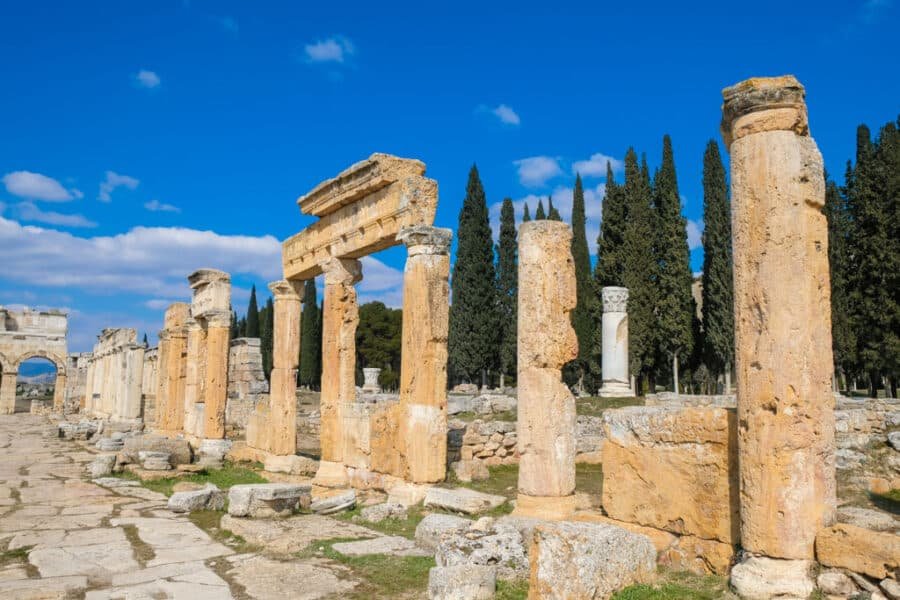
The settlement in the area became a city under the Seleucid Empire in the 2nd century BCE. Emperor Antiochus the Great populated the area with 2,000 Jewish families, which caused a mass migration of Jews to Hierapolis.
Christianity
During the first century CE, the area rapidly converted to Christianity, and a church was founded in Hierapolis. However, this era was also marked by major earthquakes, the last of which occurred in 60 CE and destroyed the entirety of Hierapolis. Nevertheless, the city was rebuilt later.
Until the 12th century, the city was ruled by the Byzantine Empire and was an important religious center with numerous basilicas and the tomb of Paul the Apostle. In the early 12th century, Seljuk Turks briefly controlled Hierapolis and fell to the Crusaders in 1190. A short time after the Crusaders conquered the area, Hierapolis was abandoned.
Entry Points To The Ancient City Of Hierapolis-Pamukkale
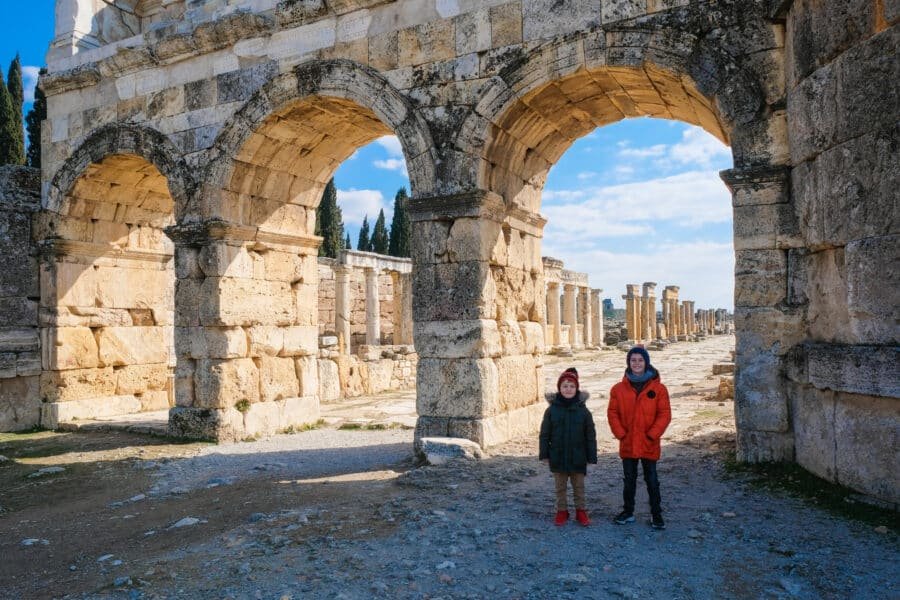
You can enter Hierapolis-Pamukkale from three places:
- The Town Center Entrance
- North Entrance
- South Entrance
All three entrance points have ticket offices.
If you go on a tour, this part won’t apply to you, but the best entrance point is the south entrance if you are like us and have a car. It took us a minute to locate it, and it was worth the 20 Lira parking fee to keep our rental vehicle safe. From there, we purchased our tickets and then stumbled across the option of golf cart rental.
Golf Cart Rental At Pamukkale-Hierapolis
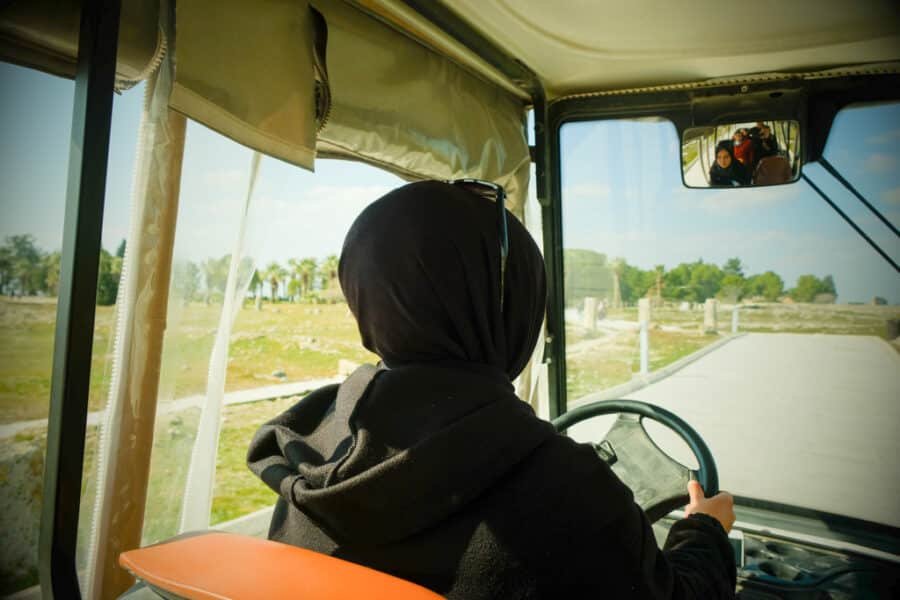
What a find this was! My younger son (aged five) can only walk so far, and although it is costly, I do not regret paying the 750 Lira fee to have someone drive us around in an electric cart for 60 minutes to see the main sights.
It was somewhat rushed, as the place is so enormous, but the driver took us to a number of sites in the city, including the ancient theatre, the bazaar, and the tombs, which we would NEVER have been able to walk that far to see given my dodgy arthritis and the small kids in tow.
I am glad we decided to take the golf cart tour of Hierapolis, given its sheer size. After the rental was over, we then explored the travertines – and the driver told us we could spend a few hours there and call when we were done to be picked up and taken back to the carpark, but that was not necessary as we walked past the travertines back to the entry point with ease.
Hierapolis-Pamukkale Entrance Fees & Opening Hours
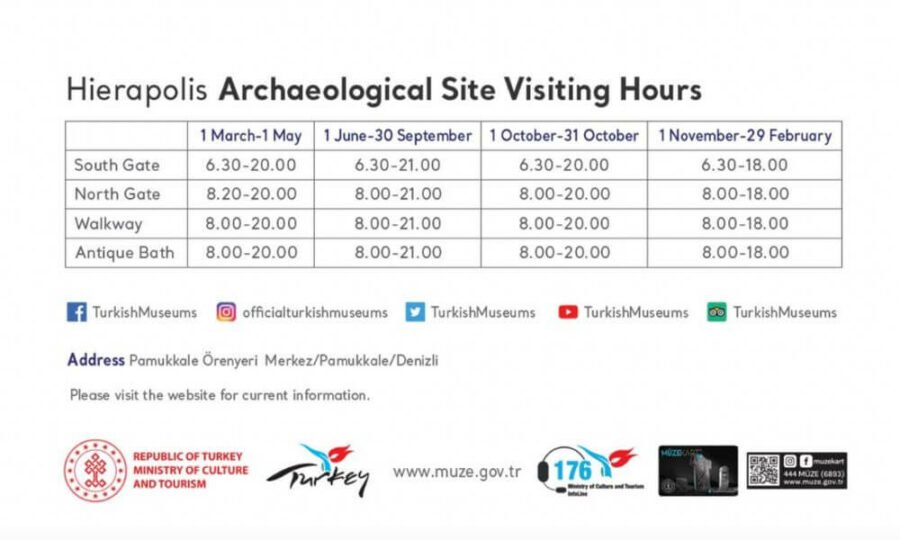
Hierapolis-Pamukkale is open from 6.30 am until 9 pm during the summer months from the south gate, and opening times in winter vary slightly according to the weather, so you will need to check out times just before you visit – in winter of 2023; the times were from 6:30 am to 6 pm.
Purchasing a ticket allows access to both the Ancient City of Hieropolis and the Pamukkale travertines.
The entrance fee is 30 euros (March 2024) for adults and children over 6 – see here for the tickets.
Parking was 20 Lira, when I went, but I imagine that now it costs at least 100.
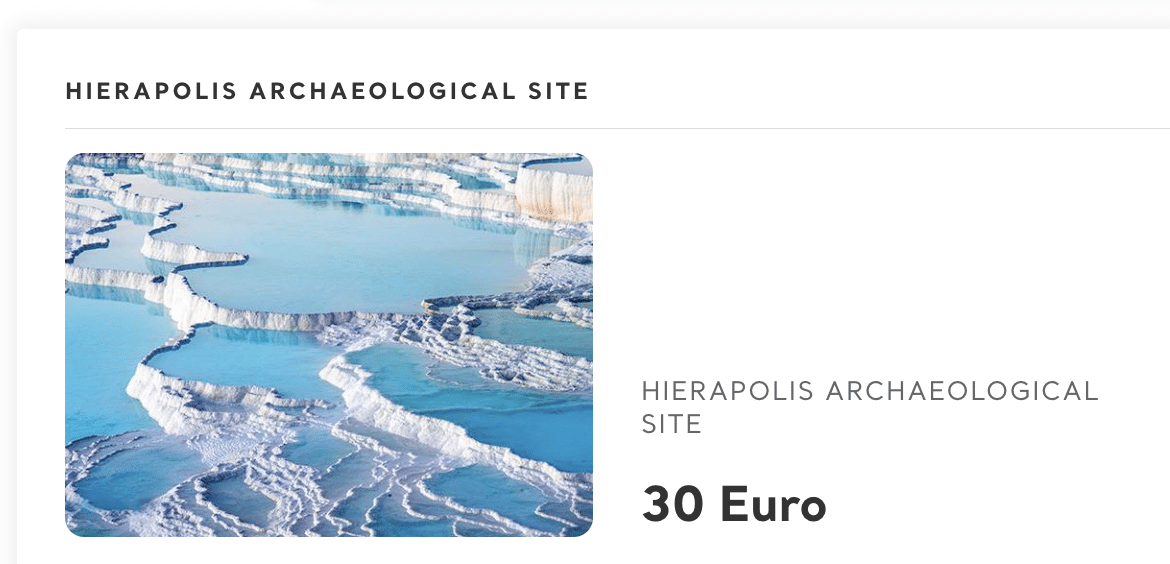
If you plan to explore more of Türkiye, the All Turkish Museum Pass also allows access to Hierapolis-Pamukkale. The cost for the pass (March 2024) is 165 euro but includes entrance into 300 museums and archaeological sites throughout the country. This pass also means you can skip the entrance line.
Brands We Use And Trust
What To See While You Explore Hierapolis
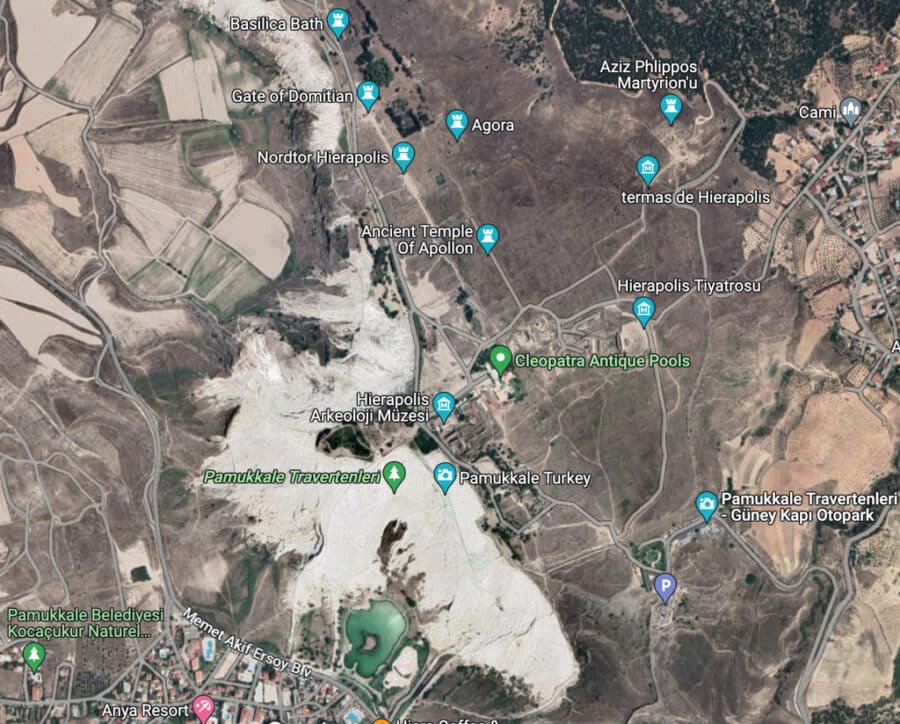
Gates Of Hierapolis
Hierapolis was a thriving Roman city renowned for its thermal springs and religious significance in ancient times. As a result, the city had a well-established infrastructure. Hierapolis has a remarkably well-preserved street, once the center of the city’s commercial and social activities, that spans over 1.2 kilometers.
The Gates of Hierapolis are a set of monumental arches that marked the entrance to the city and served as a significant religious and cultural symbol. The city’s thermal springs were considered to have healing properties and were sacred, making Hierapolis a popular pilgrimage site for many ancient civilizations. Today, visitors can explore the ruins of Hierapolis and marvel at the incredible preservation of Main Street and the old city gates, which provide a glimpse into the city’s rich cultural heritage and architectural history.
Gate Of Domitian
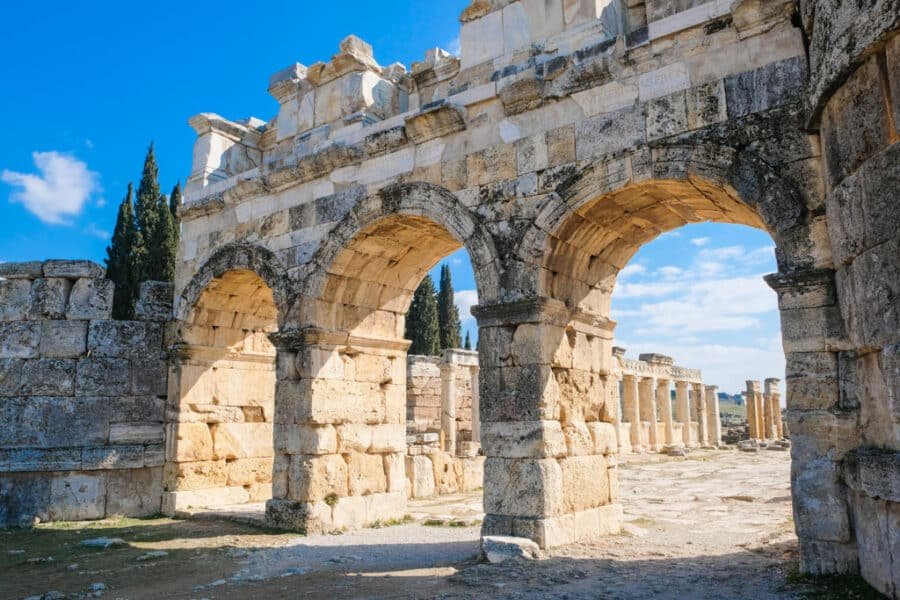
Named after the Roman Emperor Domitian, the Gate of Domitian was the main entrance to the city from the south and is distinguished by its monumental three arches and intricate carvings.
Frontinus Gate
The Frontinus Gate is another ancient gate in the ancient city of Hierapolis, named after the Roman governor Sextus Julius Frontinus. The gate was constructed during the second century AD and was part of the city’s defensive walls. Visitors can explore the ruins of the Frontinus Gate to see the complex defensive systems the ancient Romans built.
Byzantine North Gate
The North Byzantine Gate is a medieval gate in the ancient city of Hierapolis, constructed during the Byzantine period. The gate was part of the city’s defensive walls and, similar to the Frontinus Gate, was built to protect the city from invaders.
What Are the Top Sights At Hierapolis
Roman Ancient Theatre
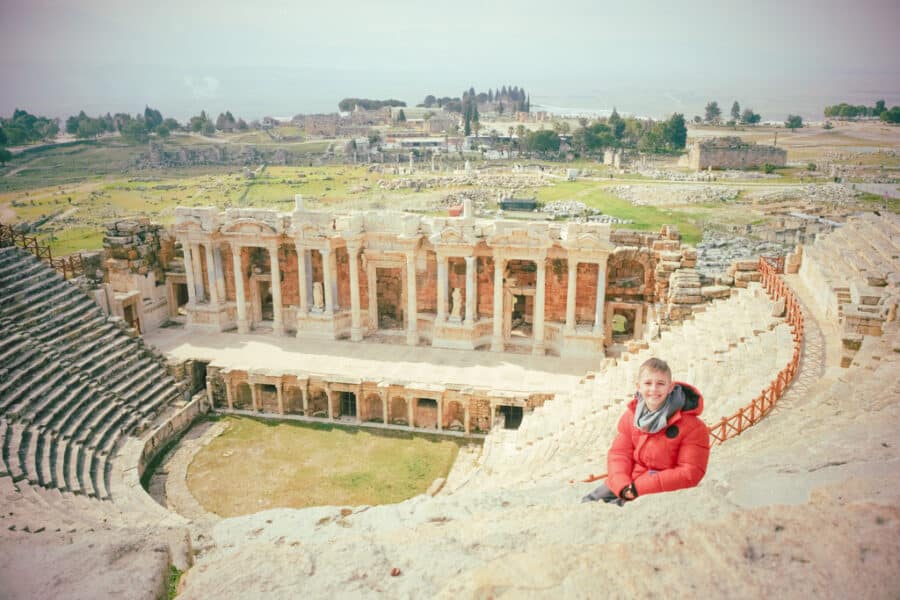
The Hierapolis Ancient Theatre is one of antiquity’s most well-preserved theatre structures. It was built in the 2nd century BCE. Our guide told us that it could seat up to 15,000 people. The theatre was used for various performances, including plays, music, and dances.
Because the Greeks founded the city of Hierapolis in the 7th century BCE and later became a Roman colony, it was an important stop on the trade route between East and West, and this theater would have no doubt in use by many travelers.

The theatre is built into a hillside and has three levels of seating. The stage area is at the bottom of the hill and is surrounded by a portico with columns. Performers and crew used several rooms behind the stage.
While there, you can only do down the first few sets of seats, not any loser, or sadly not to the main stage like I so desperately wanted to! But then, I learned that while the stage is mostly the original, the states are replicas of the original sculptures, which are now housed in the Hierapolis Archaeology Museum, which is also on-site.
Necropolis
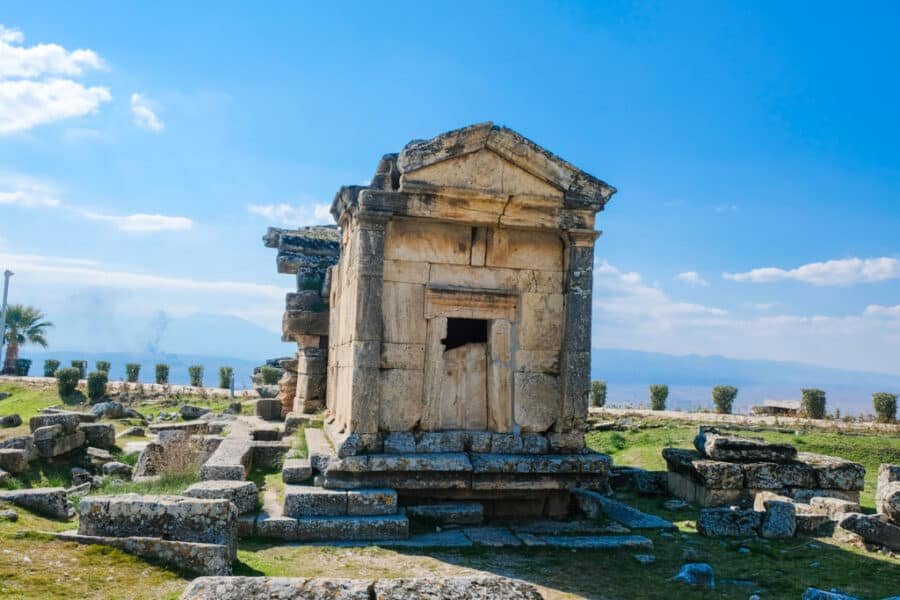
The Necropolis of Hierapolis is notable for its impressive architectural features and elaborate decorations. Many of the tombs are carved out of natural rock formations with ornate facades and intricate reliefs depicting scenes from everyday life, mythological tales, and religious iconography. Some of the most famous tombs include the Tomb of the Gladiators, the Sepulchre of the Courtesans, and the Tomb of Flavius Zeuxis.
This part of Hierpolis is vast and goes uphill, so if these are of interest, pack lots of water and an umbrella for shade during the summer months.
Martyrium of St. Philip
The Martyrium of St. Philip is a historical and religious site in the ancient city of Hierapolis in modern-day Turkey. The Martyrium is where St. Philip, one of the twelve apostles of Jesus, was martyred in the first century AD. Located on a hillside overlooking the city, the Martyrium consists of a small chapel and an underground chamber believed to contain the tomb of St. Philip.
You will need to hike to see this site to get to it, so we skipped this with our two small boys in tow.
Hierapolis Archaeology Museum
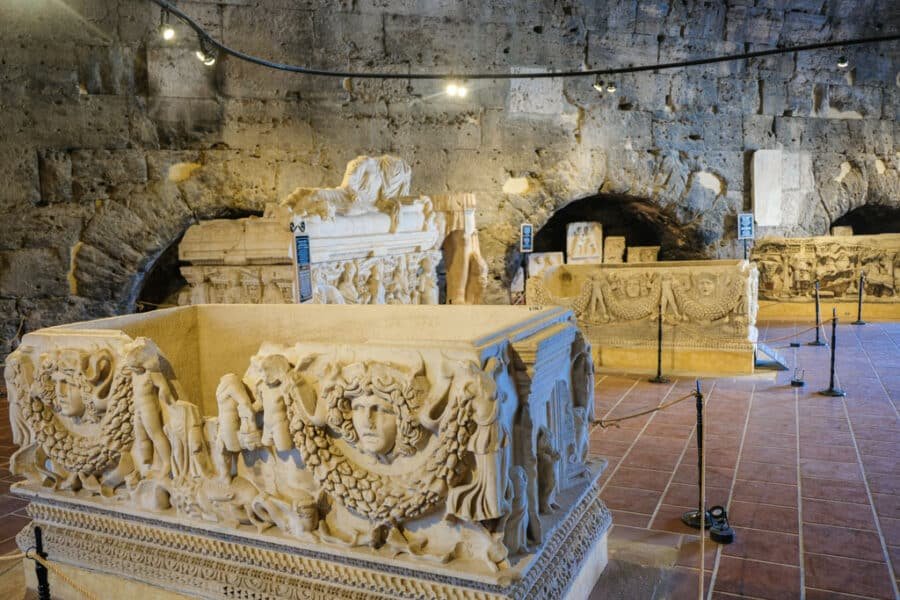
The museum houses an extensive collection of artifacts from the site and other sites in the region. The site was excavated in the late 19th and early 20th centuries, and many of its most impressive remains were moved to the museum.
The museum’s collection includes several statues of gods and goddesses and several inscribed stone slabs. One of the most interesting exhibits is a set of Roman baths used for bathing and healing. The museum also has a garden with plants that were used in traditional medicine.
The Hierapolis Museum is an important source of information about the history and culture of ancient Anatolia
Plutonian Devil’s Gate
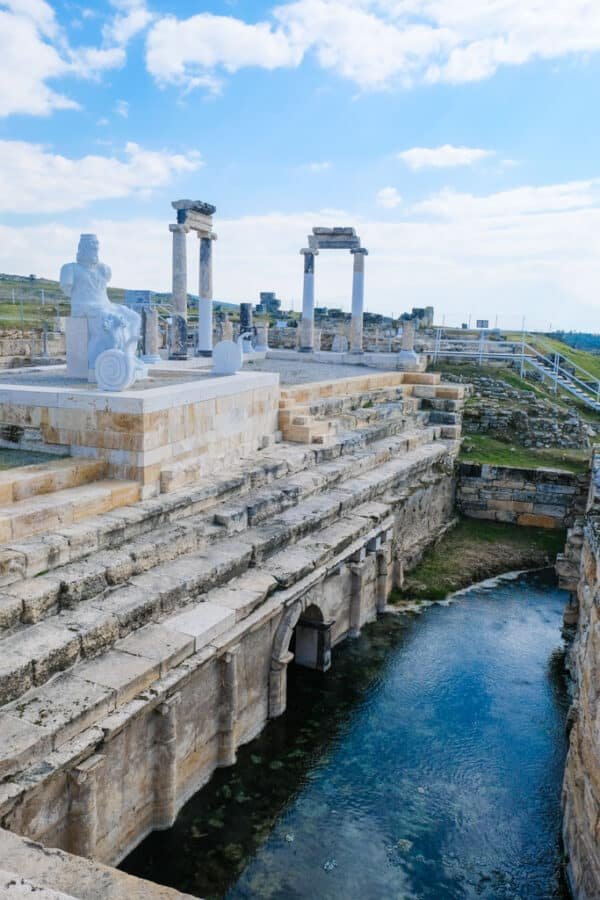
The fault lines underneath Apollo’s Temple released a toxic gas that would kill any living creature if exposed to it for too long. Stories say that the priests of ancient Hierapolis claimed it was the entrance to the underworld and that they found ways to enter the toxic part of the temple without breathing in the lethal gases, thus proving their holiness to the citizens.
Today, the sculpture of Pluto has obviously been recreated in recent renovations, but it still is a cool site.
Temple of Apollon
The Ancient Temple of Apollon in Hierapolis is an impressive historical and religious site located in the ancient city of Hierapolis in modern-day Türkiye. The temple, dedicated to the Greek god of light and music, Apollon, was constructed during the Hellenistic period and underwent several phases of renovations and additions during the Roman era. The temple was a significant center of worship in the region and was renowned for its magnificent architecture and elaborate decorations.
Basilica Bath
The Basilica Bath is a significant historical and architectural landmark in Hierapolis. The bath complex was a center of social and cultural activity in the region and was renowned for its impressive architecture and sophisticated engineering.
The bath complex once included a large central pool, several smaller pools, changing rooms, and an elaborate heating system. You can explore what is left of the bath ruins of the bath complex, which provide a glimpse into the sophisticated engineering and architectural skills of ancient Romans and a window into the daily life and customs of the people who once inhabited the ancient city of Hierapolis.
Audio Guide
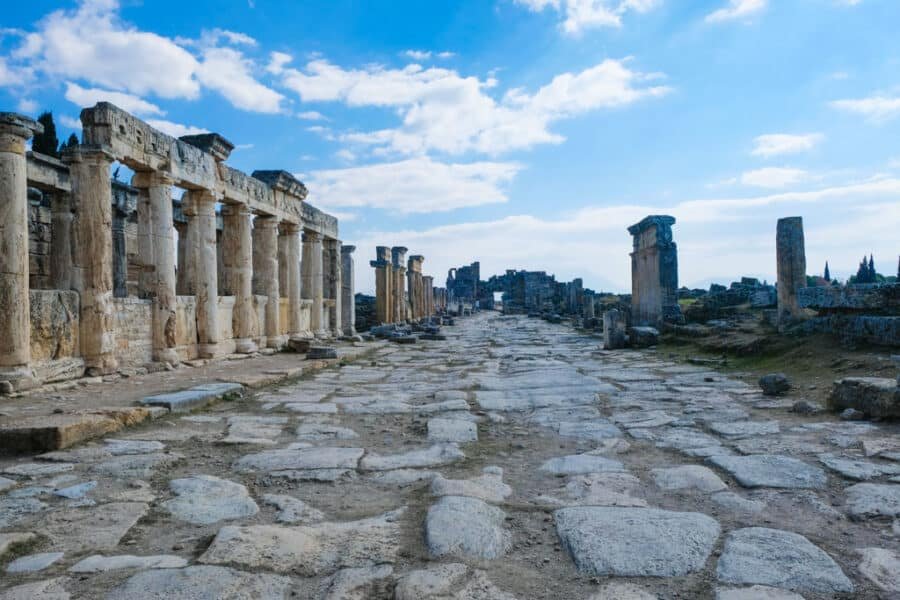
We came here to see the travertines and had no idea how massive this site was, so when we purchased our tickets, we skipped buying the audio guide. Afterward, I regretted that as I spoke to a friend who told me it gives excellent information and insight into a vast area that is overwhelming.
How Long To Spend At Hierapolis
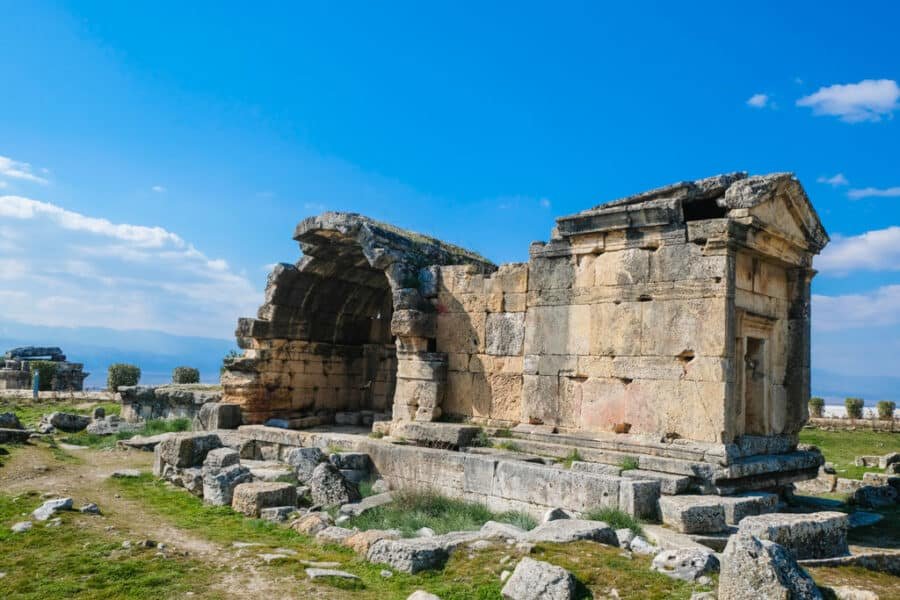
To fully appreciate all that Hierapolis has to offer, you could spend a whole day exploring the site’s numerous attractions. Start your journey with a visit to the ancient theatre, which dates back to the second century BC and once hosted spectacular performances and events.
Next, head to the Necropolis, the final resting place of the city’s former inhabitants. Here, you’ll find a remarkable collection of tombs and mausoleums that offer a fascinating glimpse into the customs and beliefs of the ancient Romans.
One of the highlights of Hierapolis is the Temple of Apollo, which was constructed during the Hellenistic period and underwent several phases of renovations and additions during the Roman era. The temple was a significant center of worship in the region and was renowned for its magnificent architecture and elaborate decorations.
Another must-see attraction is the Martyrium of St. Philip, one of the most important Christian pilgrimage sites. This holy site is where St. Philip, one of Jesus’ twelve apostles, was martyred and is a powerful symbol of the enduring legacy of Christianity in the region.
Finally, no trip to Hierapolis would be complete without a visit to the Basilica Bath, the largest of the city’s public baths. This impressive bath complex includes a large central pool, several smaller pools, changing rooms, and an elaborate heating system for temperature regulation.
How Much Does A Trip To Hierapolis Cost
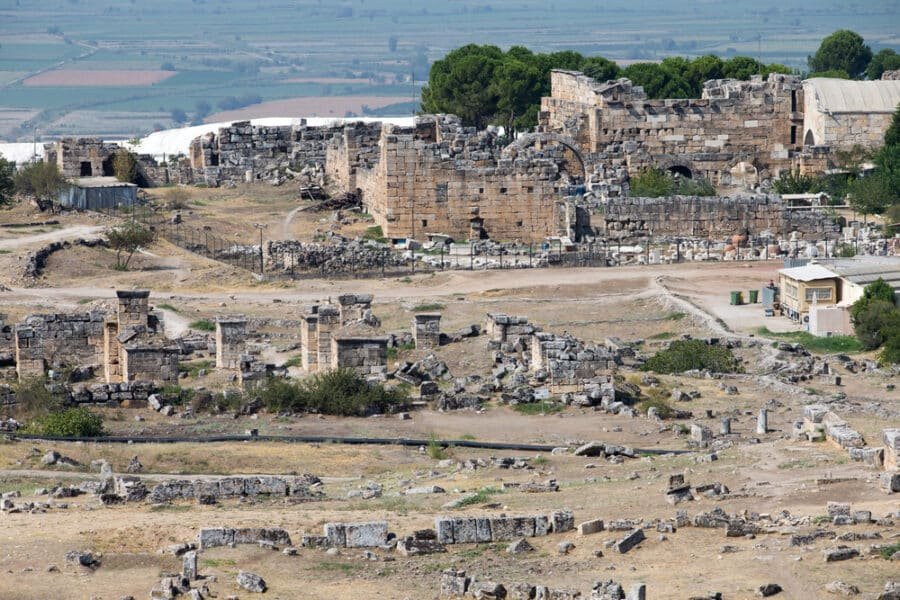
The cost of a trip to Hierapolis will vary depending on several factors, including your travel style, accommodation preferences, and the duration of your stay. Here are some rough estimates to give you an idea of what to expect:
- Transportation: The nearest major airport is Denizli Cardak Airport, approximately 20 km from Hierapolis. You can take a taxi or shuttle from the airport to the city center, which will cost around USD 20. Or, you can do as we did and hire a rental car to explore the area better. The roads are easy to drive and well-sign-posted
- Accommodation: There are various accommodation options, ranging from budget-friendly hostels to luxurious hotels. Typically, costs are USD 50-250 per night
- Admission fees: There is an admission fee to enter Hierapolis, which varies depending on the season. As of 2023, the price is approximately USD 10
- Food and drink: The area has several restaurants and cafes serving traditional Turkish options and international dishes. A basic meal typically costs USD 5-10 per person.
Overall, a trip to Hierapolis can be a relatively affordable option for travelers, especially if you are willing to stay in budget-friendly accommodations and eat at local restaurants.
What Else You Should Know About Hierapolis-Pamukkale
Tickets Are A One Time Entry
After we exited the Hierapolis-Pamukkale site, we realized we missed most of the top and back parts of Ancient Necropolis, so we drove the car to the entrance closest to it and thought we’d catch a sunset while up there – but sadly, the ticket officer denied us entry, stating that you can only enter once, despite the ticket being purchased just hours before. We explained that the small kids could not have walked that far from the entrance we came in at. A real shame that was.
Tickets are valid all day, yet you cannot return once you leave.
Other Nearby Attractions
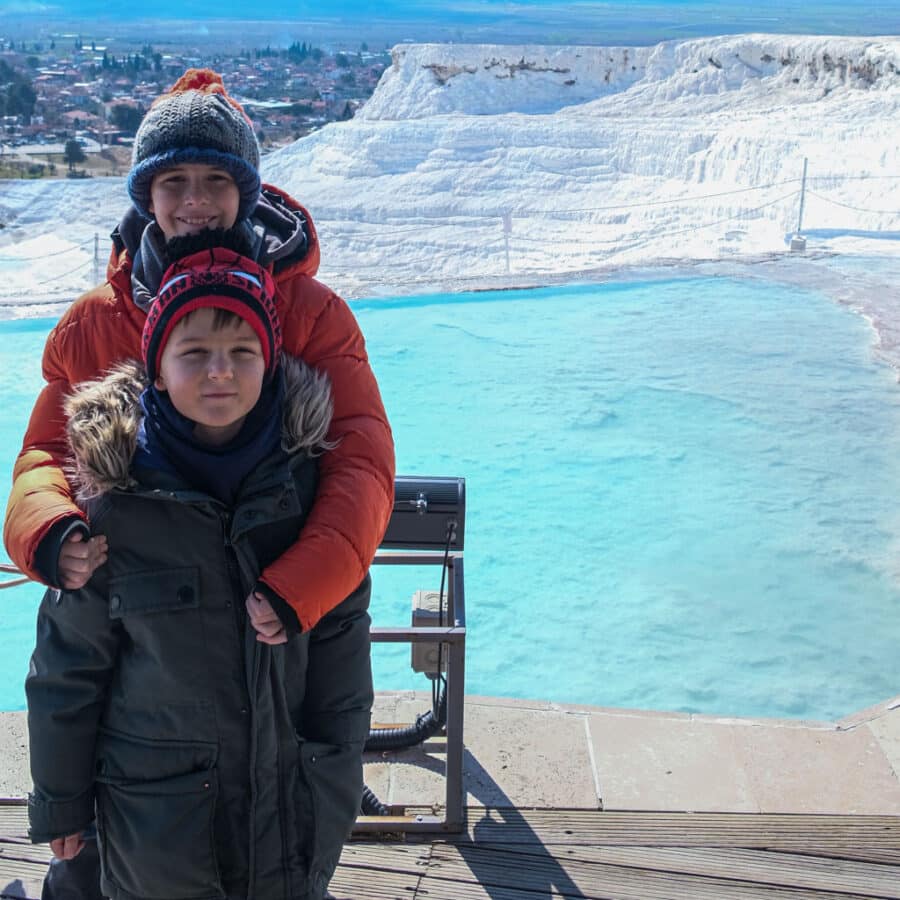
Whether you prefer to explore the ruins of ancient cities or relax in natural hot springs, there is something for everyone in the area around Hierapolis. Here is a list of other nearby attractions:
- Pamukkale Travertine Terraces – located on the same site and included in the entrance fee. Find our guide to Pamukkale here ↳
- The ancient city of Laodicea (10 km)
- Karahayit Hot Springs (5 km)
- Kaklik Cave (30 km)
- Honaz Mountain National Park (50 km)
- Colossae Ancient City (20 km)
- Aphrodisias Ancient City (100 km)
- Lake Salda (120 km)
- Sultanhisar (50 km)
- Kuşadası (180 km)
How long does it take to visit Hierapolis?
The duration of your visit to Hierapolis can vary depending on your pace and interests. Generally, visitors spend around 2 to 3 hours exploring the ancient ruins and attractions.
Is half a day enough for Pamukkale?
Yes, half a day is usually sufficient to visit Pamukkale and explore its famous travertine terraces and thermal pools. Many people combine a visit to Pamukkale with a stop at Hierapolis.
Is Pamukkale the same as Hierapolis?
No, Pamukkale and Hierapolis are not the same, but they are closely connected. Pamukkale is a natural site renowned for its terraces of carbonate minerals formed by thermal waters. On the other hand, Hierapolis is an ancient city built above Pamukkale and known for its historical ruins.
Why is Hierapolis called the Holy City?
Hierapolis earned the nickname “Holy City” due to its significance as a religious center and being used as a spa since ancient times. It was home to thermal springs, and people believed the waters had healing properties. The city was also a significant center for various religious and philosophical traditions.
Can you swim in Hierapolis?
No, you cannot swim in the ancient city of Hierapolis itself. However, nearby Pamukkale offers thermal pools where visitors can take a relaxing dip in the mineral-rich waters.
Can you visit Hierapolis?
Yes, Hierapolis is an open-air archaeological site in Turkey and is open to visitors. You can explore the ancient ruins and learn about its historical significance.
Where is Hierapolis located?
Hierapolis is an ancient Greco-Roman city located in the southwestern Anatolia region of Turkey, adjacent to the famous Cotton Castle of Pamukkale.
What are the key attractions in Hierapolis?
The city has several key attractions, including the Hierapolis theater, the Antique Pool known as Cleopatra’s Pool, the Gate Of Domitian, The Necropolis, Apollo’s Temple, and Devil’s Gate or Plutonian.
What is the history of Hierapolis?
Founded in the 2nd century BC, Hierapolis was briefly under Greek rule before becoming a part of the Roman Empire. It reached its zenith during the 2nd and 3rd centuries AD and was a popular place for the elderly and sick due to its thermal spa.
How much is the entrance fee to Hierapolis?
The entrance fee to Hierapolis, including the ruins and the Cotton Castle, is 110 Turkish Lira as of October 2021.
How much time is needed to explore Hierapolis?
The ancient city is expansive; you’ll need at least two hours for a thorough exploration, for the whole day is also possible.
Is Hierapolis worth visiting?
Yes, according to the blog post, Hierapolis is worth visiting for its unique combination of natural beauty and well-preserved historical and archaeological sites.
So, now, are you ready to explore the ancient city of Hierapolis and all it has to offer?
- The Do’s And Don’ts Of Visiting Turkey
- Best Places To Visit In Turkey For Every Type Of Traveler
- How To Get From Istanbul To Cappadocia
- Best Nightlife In Istanbul
- Day Trips To Take From Istanbul
- Greek Island Day Trip From Southern Turkey
- Best Beaches To Visit In Turkey
- Ephesus, UNESCO World Heritage Site
- How To Get From Pamukkale To Cappadocia
- How To Choose Between Antalya Or Bodrum
- Why Winter In Turkey Is A Good Idea
- Best Cities To Visit In Turkey – Urban Travel Guide
- Turkey’s Hidden Gem – Alacati Travel Guide
- Non-Touristy Places In Turkey Perfect For Instagram


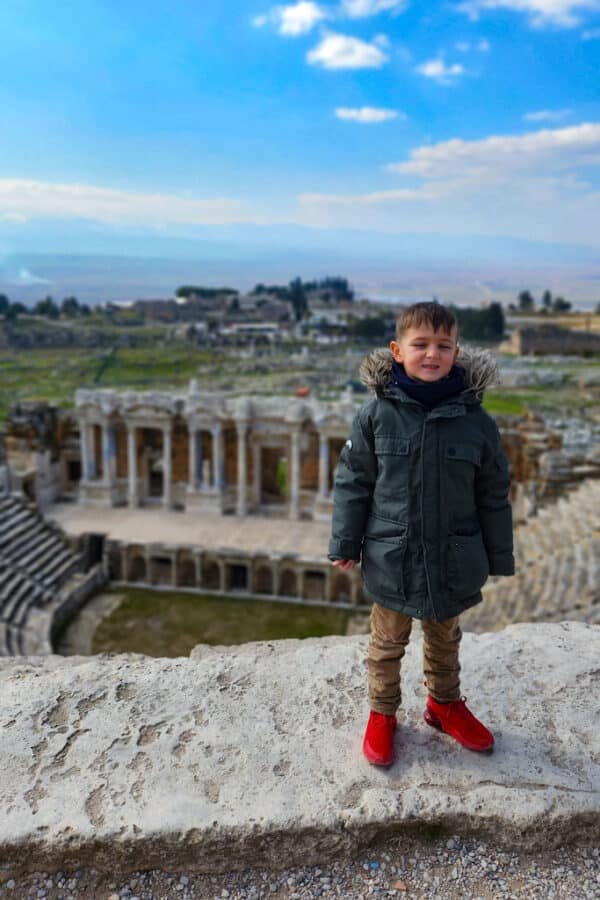
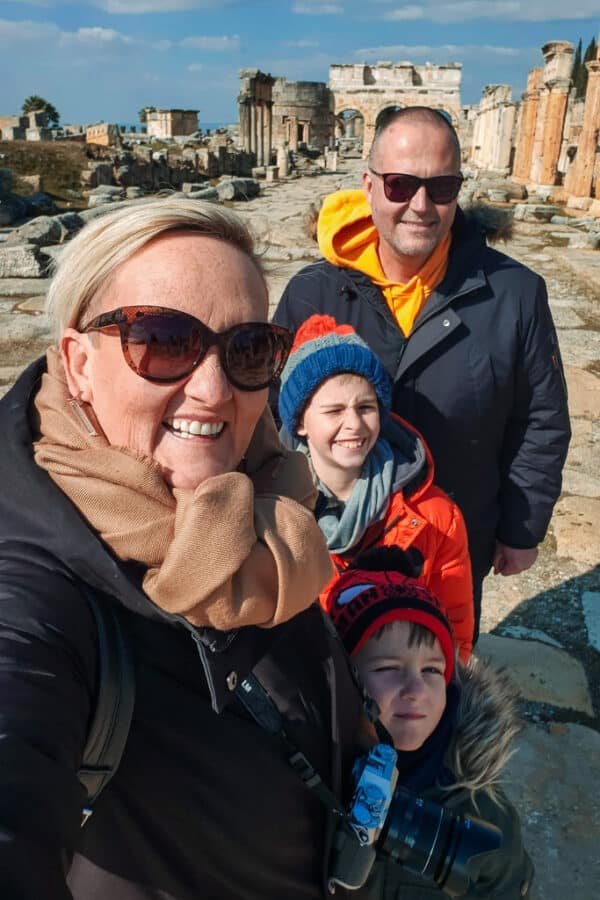
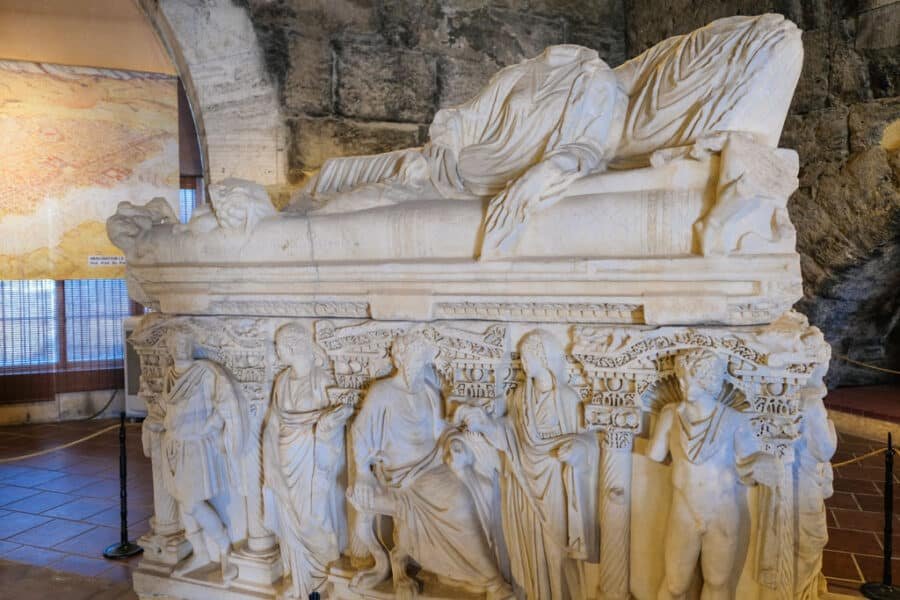
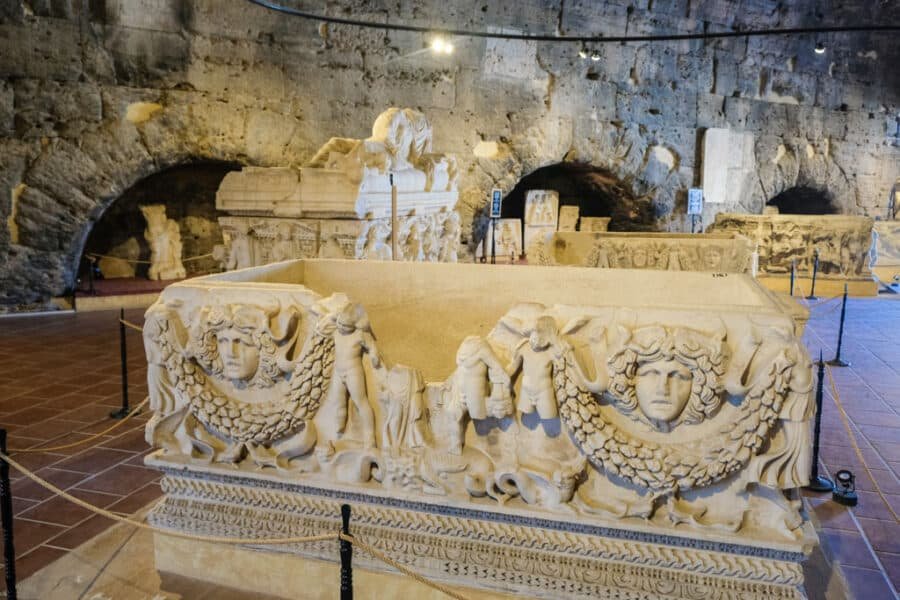
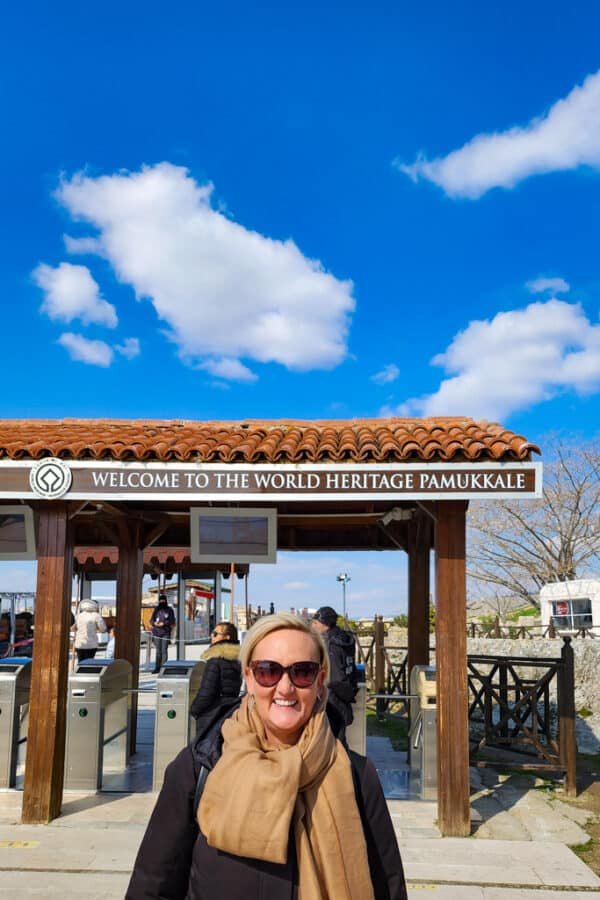

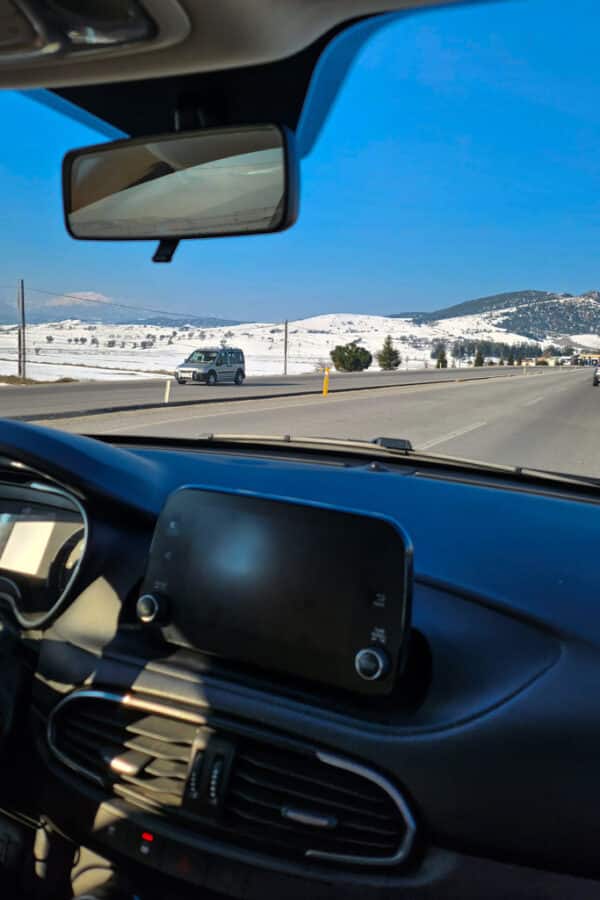
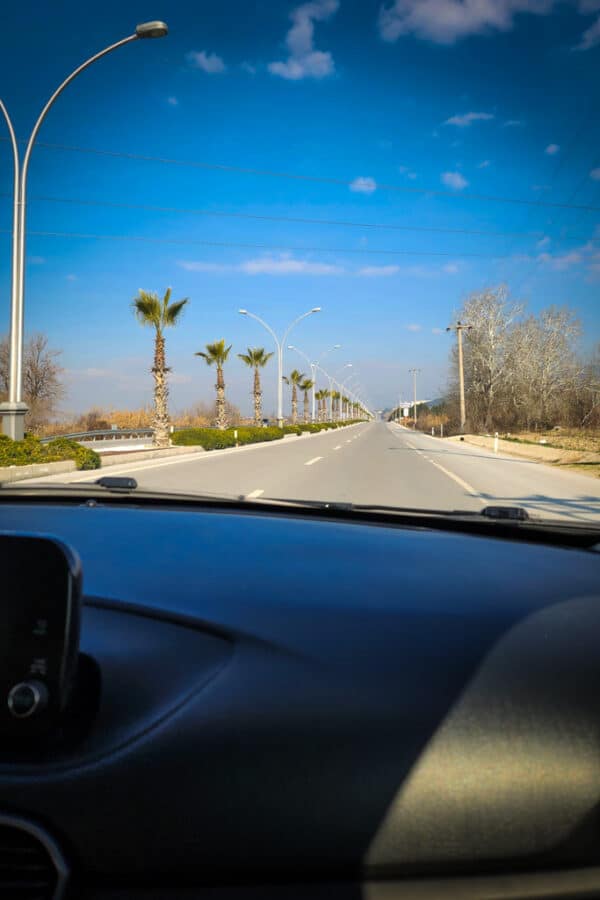
The Ancient Temple of Apollon in Hierapolis is truly incredible. I’m looking at the photos and it is similar to what we have in Spain. A few months ago I visited Merida here in Spain and its amphitheater is very similar.
Sandra
THERE WERE NO JEWS 2000 YRS AGO THEY WERE JUDAENS HEBREWS CANAANITES,THATS WHO TITUS DEFEATED
Stop screaming, you can write the same thing in regular case and still get your point across.